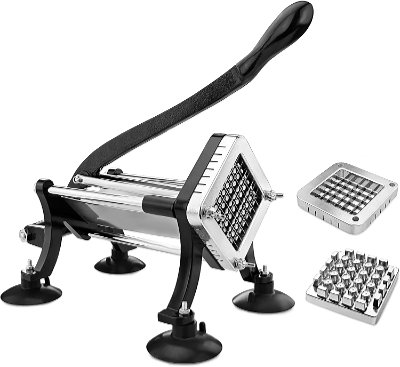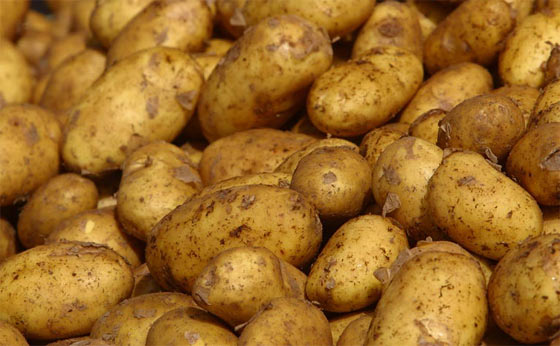Potato Survival Food
There are about 100 calories in one normal size potato. The potato has more calories than most other vegetables. This makes the potato a pretty good survival food. They are fairly easy to grow, and fairly easy to preserve.
The potato is a starchy, tuberous crop, which most people know…grows underground. It came out of South America (the Andes) 400 years ago. It has since become the world’s fourth largest food crop (following rice, wheat and corn).
If the SHTF, and you’re supplementing your food storage with whatever you can grow yourself, you might seriously consider the potato. And as commonly advised, it’s best to start learning how to grow your own food BEFORE it should become increasingly ‘necessary’.
Potato Survival Food Calories
A typical medium size potato (2 – 3 inch diameter) may have almost 100 calories. While a large potato (~ 4+ inches diameter) may have nearly 200 calories.
On average (your results may vary), each potato plant might produce 3 to 5 pounds. That translates to approximately 1,200 to 2,000 calories yield for each potato planting. You might call that one survival day? Anyway, that provides some perspective.
Here are some more attributes of the potato:
The potato has even more potassium than a banana… 40-percent more. That’s good for lowering blood pressure too.
The potato can provide almost half your requirements for vitamin C. That’s in just one potato! Prevent scurvy. Note that most of Vitamin C is apparently close to the peel.
A potato provides a-lot of fiber in their skins. So be sure to eat the skins too…
There have been many people throughout history who have relied on, and survived on, the potato. As preppers, let’s learn from history and remember that fact – when it comes planting time. Potato survival food!
Potato Farm Production
Potato farms in the United States are producing on average about 40 tonnes per hectare (~2.5 acres). That translates to 32,000 pounds per acre. And that works out to be about 3/4 of a pound per square foot (which includes distance between rows, etc.).
So with that said, you might presume that a potato garden that’s 20 x 40 feet (800 square feet, just as an example), might yield almost 600 pounds. And that equates to about 235,000 calories, or about 117 survival days.
Again, this is simply approximate, and your growing methods may vary. I’m just trying to provide some relativity between the potato as a survival food, and how it may relate to calories and garden size.
Potato survival food. A great choice for the survival garden.
Here is one resource (Wikipedia-Potato) to get you started.
Okay, not that I’m recommending eating potatoes 24/7 (diversify!!), but the following is interesting…
He Ate Potatoes For 60 Days Straight?
After the USDA had proposed eliminating the potato or restricting its consumption in various federal feeding and nutrition programs, Chris Voigt (Executive Director of the Washington State Potato Commission) decided to protest these proposals and ate nothing but potatoes for 60 days. His health improved and he lost weight. His potato-only diet attracted a lot of media attention, which helped Congress to intervene and save the potato.
It should go without saying, but all I’m simply suggesting here is that the potato be added to your gardening, so as to provide a calorie-dense supplement to everything else you may be growing. It’s all about balance (and calories when it comes to survival).
Can I Grow Potatoes From The Grocery Store?
Yes. I’ve done it. However, these potatoes are treated and/or cultivated to reduce sprouts. Why? Because consumers don’t want to see that in the grocery store. This will not completely prevent said sprouting, but, it will reduce your yields.
Instead, I recommend finding “seed potatoes” at a local supplier. That’s what I do. They’re readily available every spring in my area. Even at hardware stores ;)
Tips:
First, some store potatoes are treated so they will not sprout. Not good if you want to grow them.
Next, you have to rotate your crops. Never plant potatoes in the same bed two years in a row. That will help prevent blight.
Also, sprinkle bone meal in with your seed ‘taters for the minerals tubers need.
Never add nitrogen to spurs as you will get very healthy leaves/stems but few potatoes.
Soil needs to be more on the acidic side for them than other veggies.
Add some sulfur to the soil which also helps prevent “scab”.
Hope it helps. I love growing taters. But hey, I DO live in Idaho!! :-)
~ Randy on Modern Survival Blog
Potato Varieties
Just like most other home grown veggies, you can get many more varieties of seed potatoes than you can at the store. Some have better attributes for long term storage, such as Kenebec. This fast-growing variety has high yields. And it maintains good quality in storage. That’s what I’ve grown most often. Do your own research and discover what’s best for you. Last time I grew Yukon Gold potatoes. They tasted great. A bit smaller though.
Many disease resistant potato varieties exist, and there are even different species with different flavors and nutrient profiles. There are blight resistant potatoes such as Sarpo Mira and Tollocan, and ones that can withstand some frost such as Alaskan frostless.
Regarding Ireland and the Irish potato famine… The main issue in Ireland was that they literally grew one variety that lacked any disease resistance instead of several varieties. It was a disaster waiting to happen. It was the type of potatoes that were grown at the time. The government had been pushing farmers to switch to a version of potato that was a prolific producer. After several years when most of the country was using this same potato was when the blight hit and continued for several years. Even though the potato was a prolific producer it was also susceptible to blight which people didn’t know at the time.
Potato Storage
Regarding potato storage (cool / dark place)…
On home grown, don’t wash or clean the dug tubers. Just knock off the major dirt and call it good.
Make an insulated box that will hold humidity along with temp and darkness. And don’t just dump in a huge pile of potatoes – because you need to be able to inspect them on a monthly basis to cull the ones going bad.
A tray system works well. I have a home made tray box with 4 drawers 60″ long by 24″ deep that works great for what we use. Maybe an old set of salvaged dresser drawers that you can wrap in foam. That way you can manage your tuber supply, and there wont be ones on the bottom that will get missed and rot and wreck the whole lot.
We always have potatoes last thru April/May and most times have enough of at least a few long keepers to replant.
~ Glacialhills on Modern Survival Blog
Potato French Fry Cutter
A number of years ago I bought the following potato french fry cutter. Love it. We make french fries in a Air Fryer, rather than a vat of oil. All you have to do is lightly coat the fries with oil. Or, spray them with oil. Yummy.
Commercial Grade French Fry Cutter
(New Star Foodservice on amzn)

[ Read:
Gardening Calories List of Vegetables From A Survival Context

